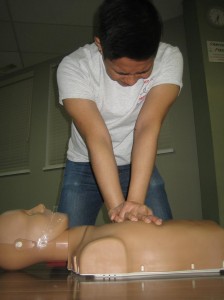Cardiac arrest vs. asphyxial arrest

When children experience cardiac arrest, they have different symptoms and causes. The most common cause of arrest in infants and younger children is respiratory in nature, primarily respiratory failure. When the children experience respiratory problems, the heart goes under a lot of stress and stops beating. This kind of cardiac arrest is termed asphyxial arrest, or arrest caused by asphyxia (lack of oxygen in the body). When you view cardiac arrest from this angle, there is a slight change or addition to the management of the situation.
Cardiopulmonary resuscitation for children
CPR for children is places a lot of emphasis on rescue breaths. Breaths are also important to management of adult cases but more focus is placed on chest compressions. Both chest compressions and rescue breaths are emphasized in pediatric CPR. Since pediatric victims are physically immature, great care must be taken when managing their cases.
When a cardiorespiratory emergency occurs in the hospital, medication and equipment are used to manage the patient. A patient, child or adult, is usually intubated (a tube is placed down the throat) to give better access to the lungs when giving rescue breaths. Rescue breaths are given with bag valve masks.
Pediatric Advanced Life Support certification
The PALS certification course we offer students is a 14 hour program that is completed in two days. It has an available re-certification class counterpart that is either 6 hours and 20 minutes or 8 hours and 20 minutes. The variation in time is due to optional stations or lessons that the student can opt out of.
The topics included in PALS certification courses are:
- Pediatric anatomy and physiology
- Pediatric-sized equipment (BVMs, ET tubes)
- Diagnostic examinations like ECGs
- Pediatric assessment
- Chest compressions and rescue breaths
- Pediatric pharmacology
We pride ourselves in hands-on training for all our courses, allowing our trainees to use the latest equipment when learning and practicing their skills. Our training centers are likewise spacious, well-ventilated, and an overall great learning environment.
The training credentials
Because PALS is a certification course, as long as you finish your training with complete attendance and pass the certification exam, we will award you with a PALS training credential. It expires after two years but can be renewed through a re-certification class. Only rescuers with training credentials that haven’t expired yet can sign up for re-certification. Re-certification for our PALS program is available through the week as well.
Enrolment
If you have decided to enroll in PALS training, you can visit our provider website to sign up. The website has an online application form you can fill out, as well as our complete contact details depending on the location you want to study at. Similarly, you can sign up at any of the locations during normal operating hours or give us a call if you want to inquire about something.
